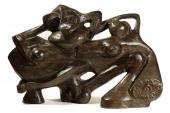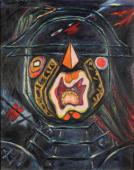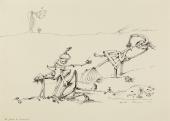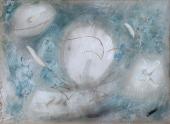Launching this gallery with this exhibition is no coincidence. We have admired André Masson’s works for a long time, and for years we have wanted to hold an exhibition of his works, one that would provide a clear, comprehensive vision of his extensive, varied artistic universe, but one that would also explore some aspects of his oeuvre that deserve our attention but that have rarely been adequately examined in the shows devoted to him to date. Our choice of his erotic drawings as well as the assembly of works that illuminate the formal affinities between his works and those of Joan Miró – with whom he shared a friendship that dated from the years on Rue Blomet – demonstrates this.
Masson was an artist who was committed to his art and his time, a tireless worker and a voracious reader. Few artists like him have portrayed loneliness and desperation, the animal instinct that underpins life and all the contrasts and contradictions that invade us. While looking at his works, one enters into the profound labyrinths of the human being. The scenes he presents spirit us away to worlds and situations that we try to ignore but that nonetheless exist. His brushstroke not only draws landscapes and objects, but also, even more importantly, he strips bare the self, making visible those hidden, inherent and immutable human passions, the ones that the unconscious returns to in order to recharge and begin again. “Tout doit revenir au feu original”, Masson himself wrote.
Pomegranates, massacres, myths; fish, birds, insects… distant elements in apparent contrast but which do not contradict each other and at Masson’s hand flow in his works in constant motion, faithful to the Heraclitian principle of constant flow, where opposites seem to end up becoming a harmonious whole. The title of the exhibition, given by the artist himself to one of his works from the transcendental 1940s, perfectly captures this: “There is no finished world”.
I do not want to end these lines without first expressing my special gratitude to the enormous help and collaboration of Diego and Guite Masson in preparing this exhibition, as well as the help of all the private collectors who have shown an interest in ensuring that it meets the objectives that had been set for it.
Michel Leiris wrote that Masson was one of those artists who “paints to think”. We would like nothing better than for visitors to leave with many questions and perhaps an answer or two. Indeed, after thinking about it for so long, we made this exhibition as food for thought as well.
Surrealist opening of Domènech with Masson
André Masson, family portrait













